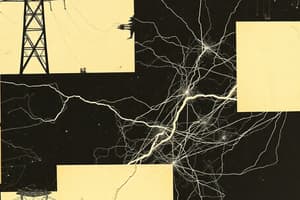Podcast
Questions and Answers
What occurs to the charges of two objects when they are rubbed together?
What occurs to the charges of two objects when they are rubbed together?
- Both objects lose their charges completely.
- Both objects gain a positive charge.
- One object gains a positive charge and the other gains a negative charge. (correct)
- Both objects remain uncharged.
What type of charge does a glass rod acquire when rubbed with silk?
What type of charge does a glass rod acquire when rubbed with silk?
- Indeterminate charge.
- Positively charged. (correct)
- Neutral.
- Negatively charged.
What happens to the silk when it is rubbed with a glass rod?
What happens to the silk when it is rubbed with a glass rod?
- It remains uncharged.
- It gains free electrons from the rod. (correct)
- It becomes positively charged.
- It loses free electrons to the rod.
Which statement is true about the conservation of charge during rubbing?
Which statement is true about the conservation of charge during rubbing?
Which of the following statements accurately describes free electrons?
Which of the following statements accurately describes free electrons?
During the rubbing process, what must happen to maintain conservation of charge?
During the rubbing process, what must happen to maintain conservation of charge?
What kind of charge does an ebonite rod gain when rubbed with fur?
What kind of charge does an ebonite rod gain when rubbed with fur?
When two objects with similar charges come close to each other, what will most likely occur?
When two objects with similar charges come close to each other, what will most likely occur?
What occurs at the atomic level during the charging process by rubbing?
What occurs at the atomic level during the charging process by rubbing?
Why does a glass rod become positively charged when rubbed with silk?
Why does a glass rod become positively charged when rubbed with silk?
Flashcards are hidden until you start studying
Study Notes
Conservation of Charge
- Objects start uncharged, resulting in a net charge of zero.
- Rubbing two objects generates equal but opposite charges on each object.
- The total charge before and after rubbing remains unchanged, illustrating the principle of conservation of charge.
Examples of Charge Transfer
- Glass rod and silk:
- Glass rod becomes positively charged after losing electrons.
- Silk becomes negatively charged after gaining those electrons.
- Ebonite rod and fur:
- Ebonite rod gains electrons and becomes negatively charged.
- Fur loses electrons and becomes positively charged.
Atomic Structure and Charge Transfer
- Atoms are neutral, comprising protons (positive) and neutrons (no charge) in the nucleus, with electrons (negative) orbiting around.
- Electrons typically equal the number of protons in a neutral atom, but some electrons can leave their atoms.
- Free electrons can transfer between rubbed objects, causing one to gain negative charge and the other to gain positive charge.
Summary of Electron Movement
- During rubbing:
- Electrons from the object with a weaker hold (e.g., silk or fur) are transferred to the stronger hold object (e.g., glass or ebonite).
- Result is a balance of charge transfer, leading to opposite charges on the two objects involved.
Studying That Suits You
Use AI to generate personalized quizzes and flashcards to suit your learning preferences.




